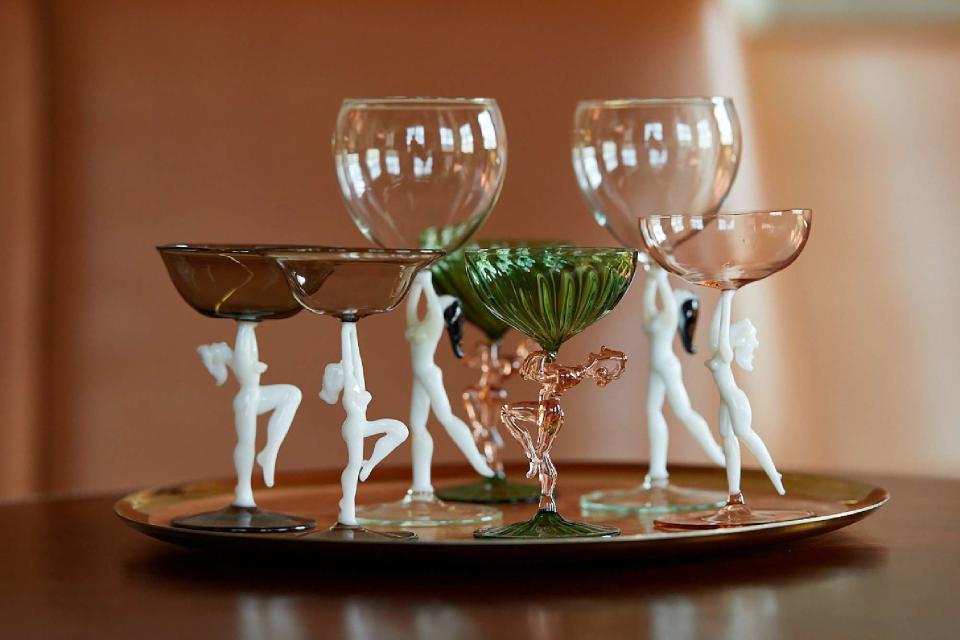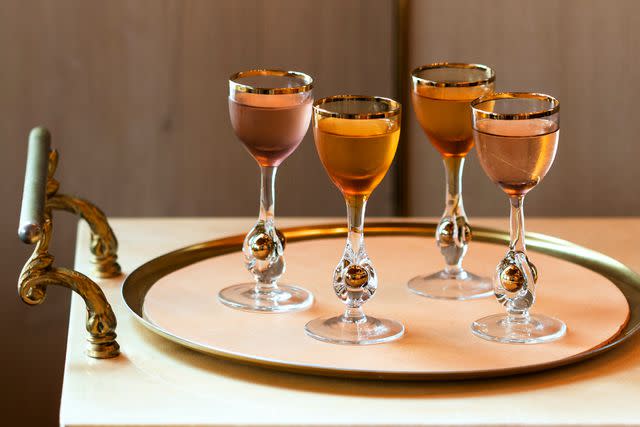How the Cordial Glass Became the Darling of Restaurant and Bar Menus Everywhere
It's not just you — those cute little glasses are familiar for a reason.

March in Houston
There’s a danger that lies within a filled-to-the-brim Martini glass — I’ve courted it on many nights. But this year, I learned that I can drink that gin-forward nectar — or really any cocktail — mindfully and stylishly from a cordial glass. It all started at J & Tony’s in San Diego, where I sipped a diminutive dirty Martini from a two-ounce glass perched on the tiniest of stems.
I count myself among one-third of American adults trying to drink less alcohol this year. In addition to stocking up on nonalcoholic aperitifs and spirits and regularly implementing sober Sundays, my experience at J & Tony’s inspired me to start using cordial glasses instead of full-sized glassware whenever I want to enjoy some of the full-strength stuff.
Cordial glasses have restraint built into their modest proportions. They gained popularity among the English upper class in the Georgian era, a time when drunkenness was particularly taboo for women. Still, those ladies retired together from dinners with delicate, often intricately patterned cordial glasses filled up with Madeira, sherry, or another sweet liqueur. In the 19th century, once glassware became more affordable, the middle class too adopted the cordial glass, along with post-dinner drinking habits.

March in Houston
During Prohibition, women and men commingled, cocktails in hand, at speakeasies. Fortified wines fell out of fashion with my grandmother’s generation, and cordial glasses began collecting dust in America’s china cabinets. But, now, they’re poised for a comeback as Millennials and Gen Zers moderate their alcohol intake and bartenders embrace miniature drinks, welcome pours, and amaro.
In addition to the “Teeny-Tiny-Freak-TINI” I drank on my last visit, I learned that bartenders at J & Tony’s serve house coffee amaro and Negroni flights in cordial glasses. Bar manager Sarah Block says flights — lined up three to a tray — help guests alleviate the stress of choosing just one cocktail.
In fact, once I started looking for cordial glasses, I found them in all kinds of bars and restaurants, including New York’s buzzy new French-Italian spot, Raf’s. After a particularly lively dinner, I happened to imbibe too many two-ounce rounds of Chartreuse (the key to moderation is stopping at just one cordial glassful), and learned that owners Nicole and Jennifer Vitagliano’s grandfather made his own cordials, including a sipper composed of blackberries and grain alcohol. Their bar program features a family recipe for anisette, along with amari and aperitivi from Brooklyn’s Faccia Brutto.
Across the country at San Diego’s Youngblood speakeasy, cordial glasses come into play for guests who want a small taste of a spirit, composed shot, or the occasional snackerie. “People are curious about what’s in the creations we make, and we use tasters to create deeper dialogue,” says bartender Liza Hoar, who sources secondhand cordial glasses at vintage stores. “I like to think they were previously used for a group of women sipping sherry while playing bridge.”
Related: Mini Cocktails Are Taking Over Drink Menus
At Chicago’s Bar Kumiko, owner Julia Momose uses cordial glasses to share small pours of sake and something she calls “component flights,” a series of sake drinks for which she breaks down a single cocktail into three glasses. “In the flight, they get the cocktail itself, a pour of the Japanese sake that inspired the cocktail, and a pour of one other Japanese component of the drink," says Momose, who buys vintage wheat-etched Sasaki glasses from Etsy and on her trips to Japan. “It is a great way to try new ingredients, as well as a chance to get a taste of the drink-making process.”
Meanwhile, dinner at Houston fine-dining spot March often concludes with a visit to the wine cellar, where guests enjoy a candlelit nightcap. June Rodil, a master sommelier and CEO of Goodnight Hospitality, collects vintage glassware to use for the experience and rotates in cordial glasses for regulars, so there’s always something new to sip from. Among her favorites are whimsical, turn-of-the-century Bimini Lauscha glasses from Austria, including miniature coupes with nude ladies for stems. “There’s just something so special about sharing history through something tactile that is no longer made,” says Rodil.
In addition to using cordial glasses for cocktail and nonalcoholic pairings, the March team serves a welcome drink of house vermouth in Japanese Kimura glassware. The handmade Kikatsu glass mimics a tiny martini glass in a nod to the March martini, which calls for the same vermouth.
This fall, I opened a 40-year-old bottle of Madeira, and after dinner, while finishing season two of “The Bear,” I drank my first nip from a growing collection of cordial glasses. From a trip to Paris, I brought home a gold-rimmed set from Marché aux Puces. My 80-something-year-old neighbor Norma also gifted me six cordial glasses, passed down from her mother. They had sat in her china cabinet, unused, for decades. I dusted them off, made a Negroni, and split the cocktail three ways: one for me, another for my husband, and the third for Norma, who’s drinking less these days too.
For more Food & Wine news, make sure to sign up for our newsletter!
Read the original article on Food & Wine.

